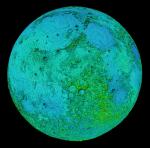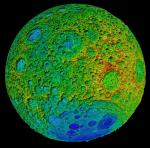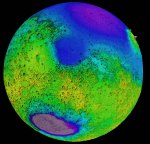As stated in the chapter “primary questions”, the moon, the earth and Mars all three have clearly different sides.
Different sides of the moon
- Moon Near (© Geodetective 2013)
- Moon Far (© Geodetective 2013)
(Click the images to enlarge) The far side of the moon is completely covered in craters. The near side of the moon does not show that many craters. On the near side, there are a few large circles, and it appears to be covered in basalt, which is igneous rock. The large circles are called impact basins and are likely craters. One potential explanation of the different sides of the moon is that the lava covered the craters on the near side, while the far side does not have much lava. This is uncertain and needs more research.
Why are the sides of the moon so different? Another answer could be that the moon is mostly bombarded on one side. If that is the case, the bombardment was very short.
Different sides of mars
- Mars 5 West (© Geodetective 2013)
- Mars 1 North (© Geodetective 2013)
Mars also has different sides. Like the moon, it has lots of craters on one side, and not so many on the other side. Scientists do not really understand why this is. Some options have been proposed, all with the idea that the craters on the north were there, but are vanished, either wiped out by a crater that covers half the planet, or by an ocean that no longer exist. But there are some craters in the north anyway, so in case of a wash away, these craters are formed afterwards. Another answer could be that Mars is mostly bombarded on one side. If that is the case, the bombardment was very short.
Different sides on earth
- Earth Back (© Geodetective 2013)
- Earth North (© Geodetective 2013)
Earth does not show very much craters. There are only about 200 confirmed craters. All these confirmed craters are on the continents. Almost all craters are burried in sediments. Earth has oceans that transport sediments. That is probably the cause for the crater burrial. Like I said before, the earth should have much more craters than it does. But like the moon, the earth has large areas that are covered in basalt (70% of the surface is oceanic crust), which is igneous rock. It looks as if the earth is missing 70% of its continental crust.
Since gravity of the earth is much stronger than gravity of the moon and Mars, impacts are much more powerful on earth. Could it be that half the earths crust has been completely destroyed? In that case, the earth has been bombarded mostly on one side. If that is the case, the bombardment was very short: if it lasted for more than 24 hours, the earth would have been cratered on all sides equally. So this does not work in a deep time framework.

Earth’s crust types. Gray is continental crust, colored is oceanic crust. Note that the map has interpretations written on it. The colors show the radioactive isotope ratios, which are interpreted as age.
Conclusion
Standard interpretations seem to have difficulties explaining the different sides of the planets and the moon. The explanation for this phenomenon differs for each planet and the moon and the explanation seems to be that the craters are washed away on half the celestial bodies. Another explanation that seems to work better for all celestial bodies is that there was a one sided meteor bombardment. If that is true, the bombardment lasted for a few hours at most. Geodetective will tentatively hold the conclusion that there has been a very short and one sided meteorite bombardment, based on this evidence.
Impact on geology
Since there are at least 200 confirmed craters on the continents, we may expect lots of craters in the ocean. Since 70% of the earths surface is ocean, the chance that, if only 200 impacts occurred, and they were all on the continents is 0.3^200 = 1 / 3.74E104. That is not realistic. So we may assume that at least around 460 craters happened in the ocean. Since impacts in water cause megatsunamis, we may expect at least 460 megatsunami layers in geology. Geologists: please point me at least 460 megatsunami layers. Have you had any chapter of megatsunamis in your books? Probably not, because it contradicts the concept of deep time.
Next step
Next step is to investigate the scenario of a short meteor bombardment. What are the consequences of such a bombardment? Does that match the features we see in our solar system?

































